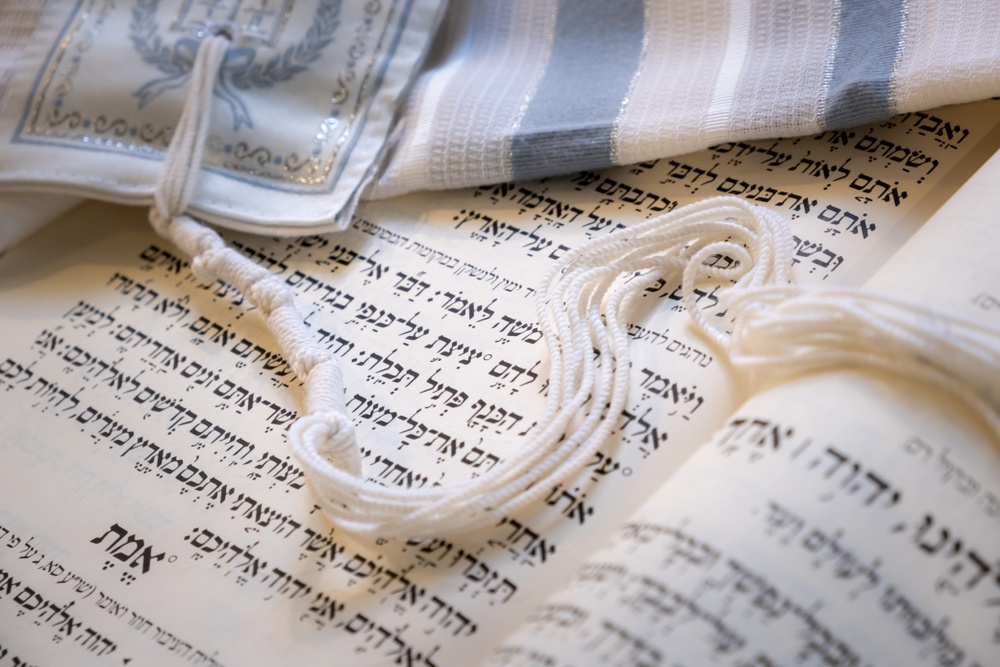
It is well known that the mitzvah of tzitzit is a classic case of a mitzvah aseh shehazman grama, a time-bound positive mitzvah from which women are exempt[1]. Though there are as many exceptions to this rule as the rule itself, tzitzit is one of the mitzvot that follow the general rule[2]. This is based on the verse u’re’item oto, that you shall see the tzitzit (Bamidbar 15:39), from which our Sages derive that tzitzit are obligatory only at a time when one can naturally see—i.e., during the daytime.
Yet it is not quite so simple. Not all agreed that tzitzit is, in fact, a time-bound mitzvah. The Gemara relates that Rav Yehuda would put tzitzit on the clothes of his wife, as he held that the mitzvah to wear tzitzit is not time dependent. The mitzvah to see the tzitzit means that looking at the tzitzit is the catalyst to remind ourselves of all other mitzvot and thus, we—men and women—are obligated to wear them at all times.
This view of Rav Yehuda is not a minority opinion. “Our Sages taught: All are obligated in the mitzvah of tzitzit; kohanim, levi’im, yisraelim, women and slaves. Rabbi Shimon exempts women because it is a time-bound mitzvah” (Menachot 43a).
In keeping with the Talmudic rule of jurisprudence that, when “an individual and many” have a dispute, “the law is like the many”, we should rule in accordance with the view of the Sages that women are, in fact, obligated in the mitzvah of tzitzit. Yet such is not the case. It is the view of Rabbi Shimon that is accepted in all halachic codes.
As Tosafot (Kiddushin 34a, s.v. u’tefillin v’tzizit) notes, other Talmudic passages are based on the assumption that women are exempt from tzitzit and Rabbi Shimon’s view is not just that of one individual.
Of course, the fact that women are exempt from tzitzit does not mean they may not wear them[3]. Just as no observant women would think of missing shofar, and an almost equal number sit in the sukkah and take the lulav, one would have expected that pious women would don tzitzit (and a tallit). And the Rambam (Hilchot Tzitzit 3:9) specifically rules that they may do so. The RaMah (Orach Chaim 17:1), commenting on the ruling of the Shulchan Aruch that women are exempt from the mitzvah of tzitzit, begins his discussion with the unequivocal halachic ruling that, “if they want to wrap themselves [in a tallit] and make a blessing, that is their prerogative.” Women are not obligated to wear tzitzit, but there is no reason for them not to do so.
Yet as we all know, such is not the case, and it is the rare Orthodox shul that would tolerate a woman donning a talli, likely censuring those who might want to do so. Why? The RaMah continues, saying that, “However, to do so [wear a tallit], mechzei k’yuhara, has the appearance of religious arrogance, and therefore, they should not wear tzitzit”.
Unlike shofar, sukkah and lulav, there is no personal obligation to wear tzitzit. If a man happens to be wearing a four-cornered garment he, but not a women wearing such a garment, would be required to add tzitzit—but there is no obligation to actually wear a four-cornered garment[4]. To make a special purchase of clothing just to be able to wear tzitzit, eventhough a women need not put tzitzit on a four-cornered garment she may be wearing, was seen as religiously presumptuous and hence, inappropriate. But had there been a requirement (for men) to actually wear a four-cornered garment, then it would be laudatory—though not required—for women to do so.
While the RaMah does not explicitly say so, it appears that if four-cornered clothing were to come back into style, then it would be most appropriate for women to add tzitzit to their clothing. It is one thing to suggest that one need not buy an extra piece of clothing to fulfill a mitzvah one is not required to fulfill in any event; it is quite another to say that one who is already wearing this clothing should do so without the benefit of tzitzit.
The ruling of the RaMah should be understood not as recommending that women not perform mitzvot, but as reflecting the great demand of halacha that we must not use mitzvot to display our piety to others; something that applies equally to men and women. Mitzvot bein Adam leMakom, between mand and G-d, are meant to deepen our relationship to G-d, not to serve forum to display our religiosity. Just as it is azut panim, haughtiness, to reveal one’s sins against G-d (Rambam Hilchot Teshuva 2:5), so, too, it is arrogant to publicize one’s performance of mitzvot to G-d[5].
The dangers of yuhara manifest themselves daily, and we must constantly be on guard against using mitzvot for our own personal agendas. One need look no further than tzitzit for another example. As discussed in our last post, many halachic authorities rule that it is inappropriate for men to wear their tzitzit out as that, too, is an unnecessary display of religious arrogance. Only those recognized as G-d-fearing people—the examples Rav Herschel Schachter used to demonstrate this point were the likes of Rabbi Soloveitchik and Rabbi Moshe Feinstein—should do so.
Doing mitzvot in the most meticulous fashion is wonderful, if one is ready for such. When going beyond the call of duty in our obligations to G-d (as opposed to man, where it is always appropriate), we must ensure that it is G-d whom we are worshipping.
[1] The rule is listed in the Mishna without explanation and the Gemara bases it on the juxtaposition of various Biblical verses (see Kiddushin 34a-b). However, no explanation is offered as to why women should be exempt from time-bound positive mitzvot.
The Abudraham (14th century Spain) suggests that this exemption was granted in order to preserve peaceful relations between husband and wife. Working on his clearly stated assumption that a wife is subservient to her husband, the exemption avoids a situation in which there is a conflict between having to carry out the will of one’s husband and that of the Creator. Since the Torah allows the name of G-d to be erased to preserve peace in the home (in regard to a suspected adulteress), how much more so can one be exempt from a mitzvah to preserve peace in the home.
While this may grate on the modern ear, the subservience of the wife to husband was a given in medieval Spain (and everywhere else). More-modern authorities tweak the Abudraham, rooting the exemption in the notion that a women’s time is not her own due to obligations in the home, especially that of raising children. This does little to explain why single woman and those whose children are independent are also exempt and is, for at least some moderns, likely no less grating.
For one analysis of this and other related issues, see The Status of Women in Halakhic Judasim, by Rabbi Saul Berman here.
[2] If one includes the rabbinic mitzvot of Chanukah, Purim and drinking four cups of wine on Pesach, there are more exceptions to the rule than the rule itself. Other exceptions include kiddush on Shabbat, matzah, simcha on Yom Tov, participating in the hakhel ceremony, fasting on Yom Kippur and bringing a korban Pesach. The seven mitzvot where this rule is applied are tzitzit, tefillin, shofar, sukkah, lulav, counting the omer and, perhaps rather surprisingly, reciting the shema.
[3] Discussions on women and ritual tend to, sadly, be of a polemic nature and often centre on issues of policy, politics and power. I will try to the best of my ability to avoid such. These non-comprehensive divrei Torah are not for practical halachic rulings, but to provide some insights and ideas that I hope you find meaningful and worthy of contemplation and discussion.
[4] This is the basis of the widespread Ashkenazic custom that men do not wear a tallit until they are married. If one was actually obligated to wear tzitzit, such a practice would be unimaginable; could one entertain the possibility that one puts on tefillin only at marriage? By having the singles stand out, others know to help them find wives—or maybe just to invite them for a Shabbat meal.
[5] When dealing with mitzvot—or sins—against our fellow man, we should make our actions public. Revealing one’s mitzvot can inspire others to follow suit, and revealing one’s sins is both a form of atonement and a way to ensure that the victim’s reputation does not suffer.



